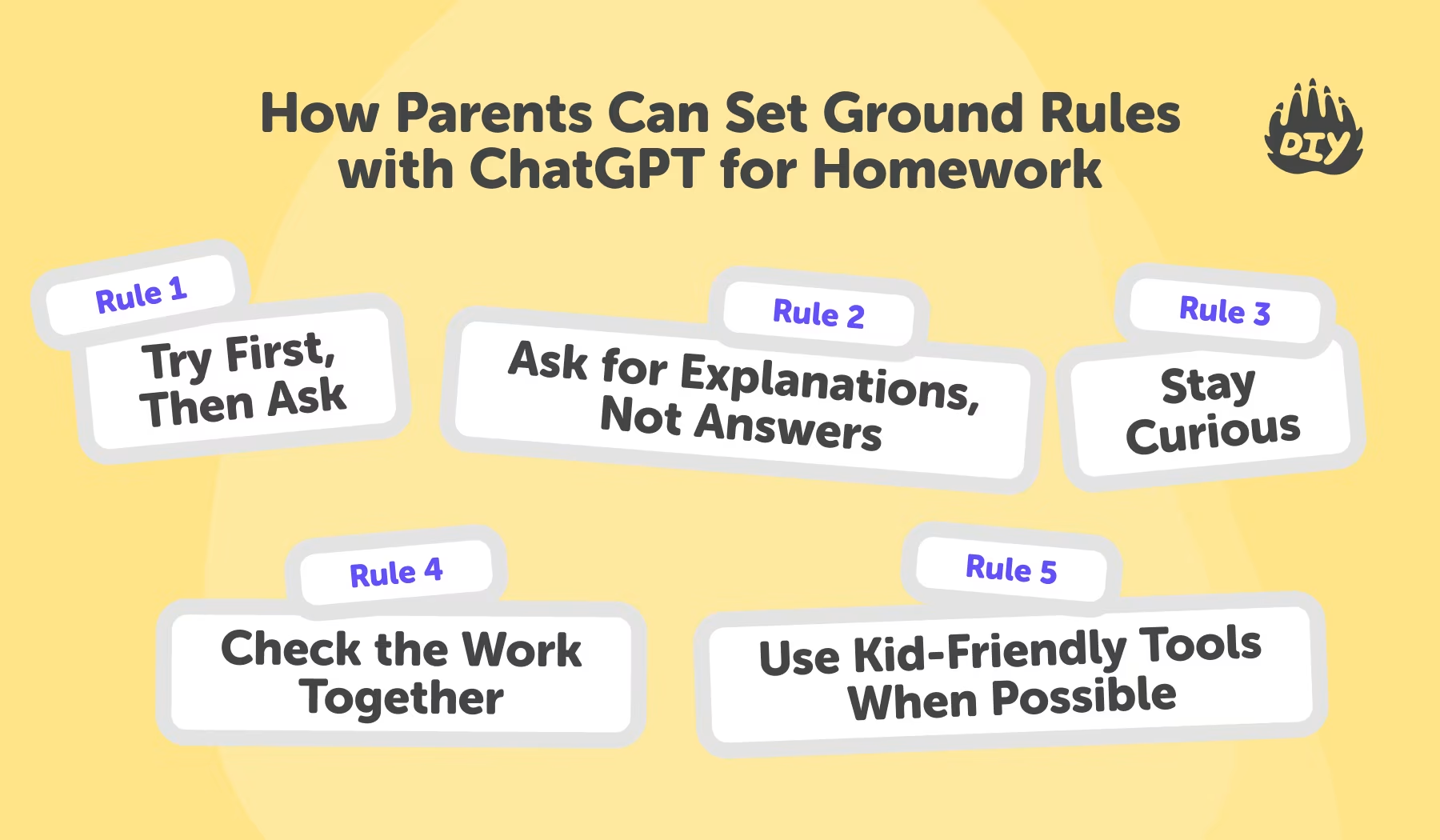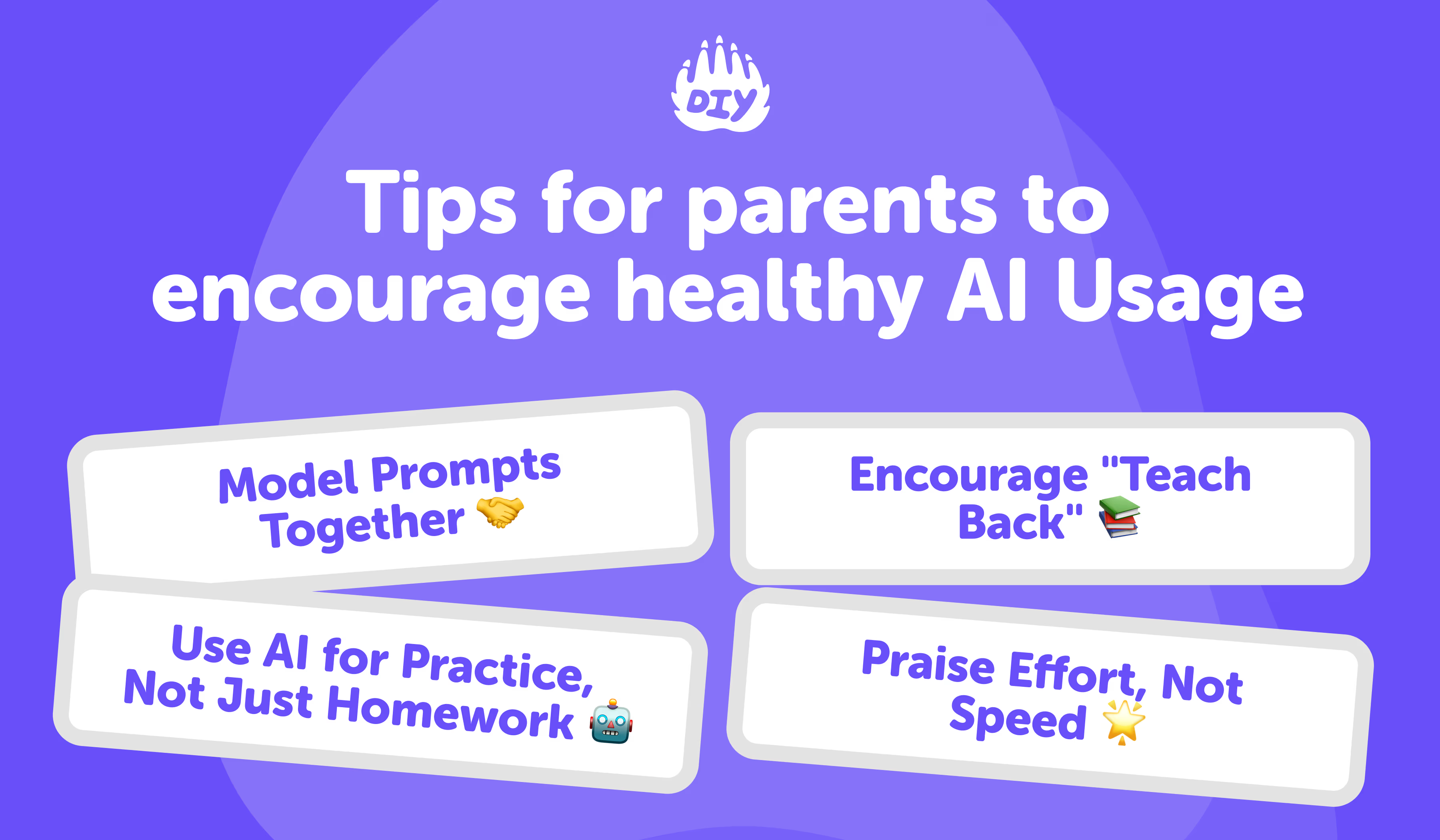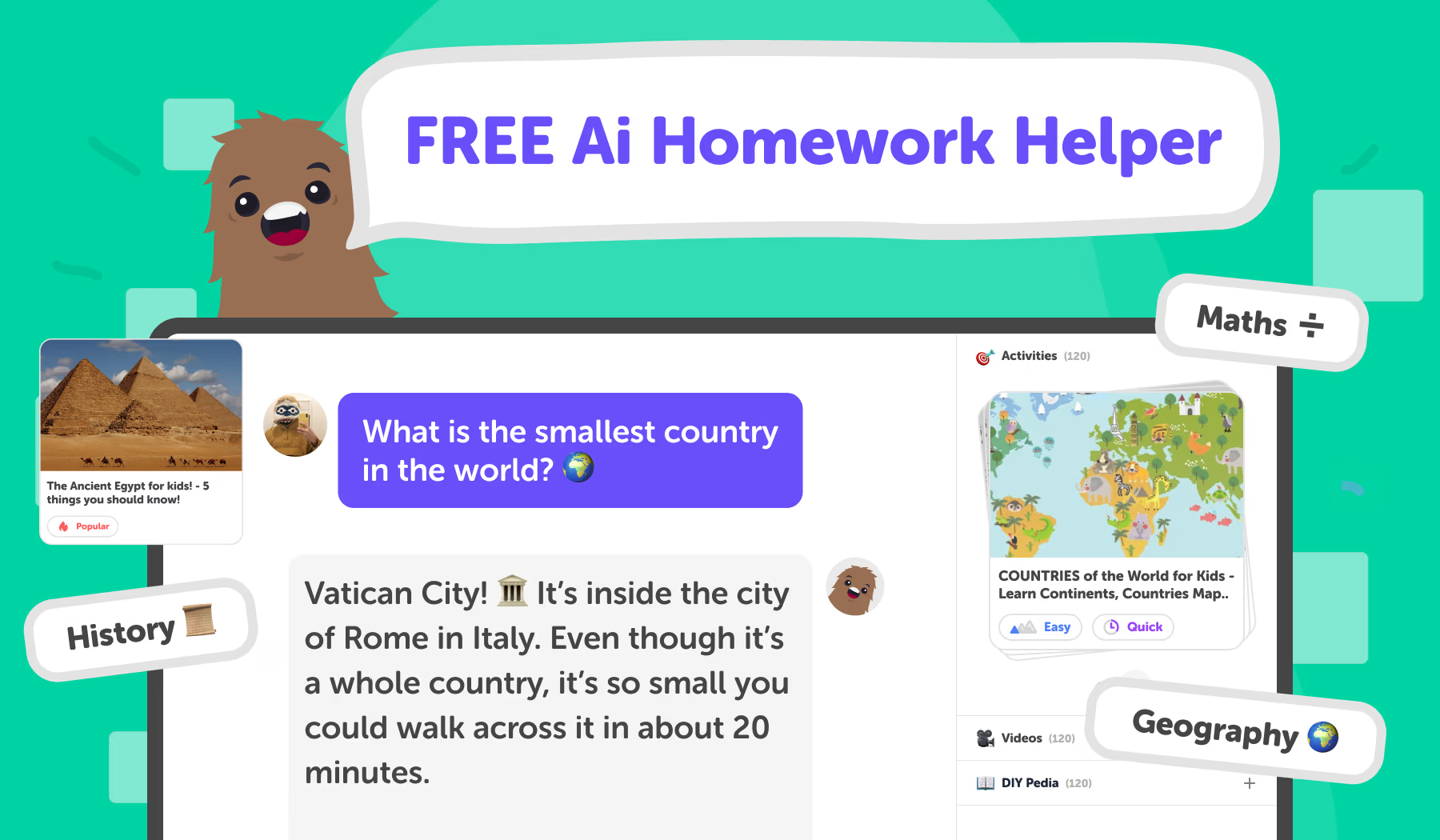ChatGPT can help kids plan, understand directions, and check ideas but it shouldn’t write the work for them. Set clear rules: use it to explain, outline, generate prompts, and self-check, then put answers in their own words with text evidence. Below, find parent settings, do/don’t lists, and kid-safe alternatives.
When ChatGPT burst onto the scene, many parents had the same reaction: “Wait, does this mean my child can just copy homework from a chatbot?”
Turn AI Into a Study Coach, Not a Shortcut. Give your child step-by-step help, kid-safe prompts, and no copy-paste answers. Try the AI Homework Helper
Why Parents Worry About AI in Homework (and How to Use It the Right Way)
You’re not wrong to be cautious. With a few prompts, ChatGPT can draft essays, solve math problems, and summarize chapters exactly the kind of homework help that can tempt kids into shortcuts. That’s why searches like “is ChatGPT cheating?”, “ChatGPT for kids,” and “how to use ChatGPT for homework” are booming. The concern isn’t the tool it’s how it’s used.
Here’s the other side: used well, AI can explain math in plain language, create practice quizzes, and re-teach a history concept in kid-friendly steps. Think of it like a calculator or Google: not “good” or “bad,” but powerful. Your role is setting clear rules so AI becomes a learning ally, not a crutch.
What Parents Are Right to Worry About
Copy-paste answers instead of real learning (plagiarism, academic integrity issues).
Over-reliance on AI for essays, book reports, and take-home tests.
Privacy and safety when kids use open tools without parental controls.
Mismatch with school AI policy or teacher expectations.
What Responsible AI Use Looks Like
Explain, don’t write: “Show the steps,” “Explain this in 2–3 sentences,” “Give me practice questions.”
Outline first, write later: Use AI for outlines or study guides, then kids draft in their own words and cite sources.
Self-check mode: Ask AI to check reasoning, point out gaps, or offer counterexamples.
Skill building: Turn a chapter into flashcards, quizzes, or a 1-minute summary to boost study habits.
Simple Family Rules (Post These Near the Desk)
No full answers. AI can explain, outline, or quiz, but the writing is yours.
Show your work. Turn in notes, drafts, and the sources you used.
Quote or paraphrase? If you use an idea, cite it—no copy-paste.
Follow school rules. Ask the teacher how AI is allowed in this class.
Use kid-safe tools first. Prefer a kid-safe AI homework helper with built-in guardrails and age-appropriate prompts.
When your child asks AI a question, add “Explain like I’m in 5th/7th grade” or “Show two examples and one counterexample.” These ChatGPT prompts for students build understanding without giving away the final answer.
If you want built-in guardrails, step-by-step guidance, and safer defaults, try a kid-safe AI homework helper. It nudges kids to think, cite evidence, and practice, not just finish faster.
ChatGPT vs. Kid-Safe AI Homework Helper
Tool | Use For | Avoid | Try Instead | Result |
ChatGPT | Clarifying instructions, example questions, brainstorming study steps | Full answers, essays, take-home tests, anything that bypasses thinking | — | — |
Kid-Safe AI Homework Helper | Guided prompts, step-by-step hints, built-in guardrails | — | Fewer copy-paste risks, better study habits |
5 AI rules for parents and homework

Rule 1. Try First, Then Ask
Encourage kids to attempt homework before turning to ChatGPT. That way, they build persistence and use AI as a check, not a crutch.
Rule 2. Ask for Explanations, Not Answers
Model prompts like: “Explain how to solve this” instead of “Give me the answer.”
Rule 3. Stay Curious
Encourage your child to ask extra questions, like “Why does this work that way?” ChatGPT can spark curiosity beyond assignments.
Rule 4. Check the Work Together
Sit down and ask your child to explain what they learned in their own words. If they can teach it back, they’ve understood.
Rule 5. Use Kid-Friendly Tools When Possible
ChatGPT isn’t designed for children. The DIY.org homework helper tool is built with guardrails so kids can’t misuse it for shortcuts.
Tips for Parents to Encourage Healthy Use

Model Prompts Together
Sit with your child and show them how to type: “Explain long division step by step.” Let them see how the wording changes the quality of the answer.
Encourage “Teach Back”
Ask your child to explain the AI’s answer to you. If they can put it in their own words, they’ve actually understood.
Use AI for Practice, Not Just Homework
ChatGPT can create quizzes, flashcards, or practice problems. This turns homework from “done” into “reinforced.”
Praise Effort, Not Speed
If your child says, “ChatGPT made this faster,” remind them learning is more important than finishing quickly. Celebrate when they use AI responsibly.
What Teachers Are Saying About ChatGPT
Teachers often fall into two camps: cautious or optimistic. Most agree on one thing: AI is here to stay. Schools will adapt, but the best safeguard is teaching kids how to use it responsibly. That’s where parents make the biggest difference.
Cautious teachers worry about plagiarism, dependence, and lost critical thinking. They’ve already caught students turning in AI-written work.
Optimistic teachers see opportunities: personalized explanations, saved classroom time, and creative ways to engage kids.
Make “Explain it, don’t write it” the rule. Get guided prompts that teach thinking outlines, examples, and practice questions. Open AI Homework Helper
Parents’ Biggest Questions
Is ChatGPT good for homework?
Yes for planning, clarifying, and checking understanding; no for writing full answers or essays.
How should kids use ChatGPT without cheating?
Use it to explain steps, outline tasks, or create practice questions, then write answers independently.
What are safe ChatGPT settings for kids?
Create a family account policy, avoid sharing personal info, and review conversation history together.
What prompts help with reading and writing?
“Explain this in 2–3 steps,” “Give me three practice questions,” “Show two examples and one counterexample.”
Can teachers detect ChatGPT?
Detection isn’t perfect focus on process: drafts, notes, and citing sources.
What’s better for kids ChatGPT or a homework helper app?
A kid-safe helper adds guardrails, age-appropriate prompts, and study routines; ChatGPT needs close supervision.
Is using ChatGPT for homework cheating?
It depends on how it’s used and your school policy; planning and self-checks are usually OK, copying is not.
How do I talk to my child’s teacher about AI use?
Share your family rules, ask for class guidelines, and agree on when AI is allowed.
See How Parents Can Use ChatGPT Together
For a clear look at AI in homework, watch: How ChatGPT Can Help With Schoolwork | Family Guide.
It explains how families can approach AI with curiosity and care.
The Future of AI in Family Learning
Just like calculators, spellcheck, and Google before it, AI isn’t going away. In the coming years, tools like ChatGPT will become as normal in classrooms as textbooks.
The real challenge isn’t banning it, it's teaching kids how to use it responsibly. Parents who start those conversations now are preparing their kids for a future where AI is everywhere.
That’s why many families are turning to the DIY.org homework helper tool, which makes responsible use simple and safe.
The Bottom Line

ChatGPT can be a blessing or a curse for homework. Used without rules, it can make kids skip the effort. Used with guidance, it can spark understanding, curiosity, and confidence.
Parents hold the key. With clear rules, good prompts, and thoughtful conversations, AI becomes less of a threat and more of a tutor.
And for the safest, most kid-friendly option, the AI Homework Helper was designed exactly for this purpose: making sure AI helps kids learn smarter, not lazier.




